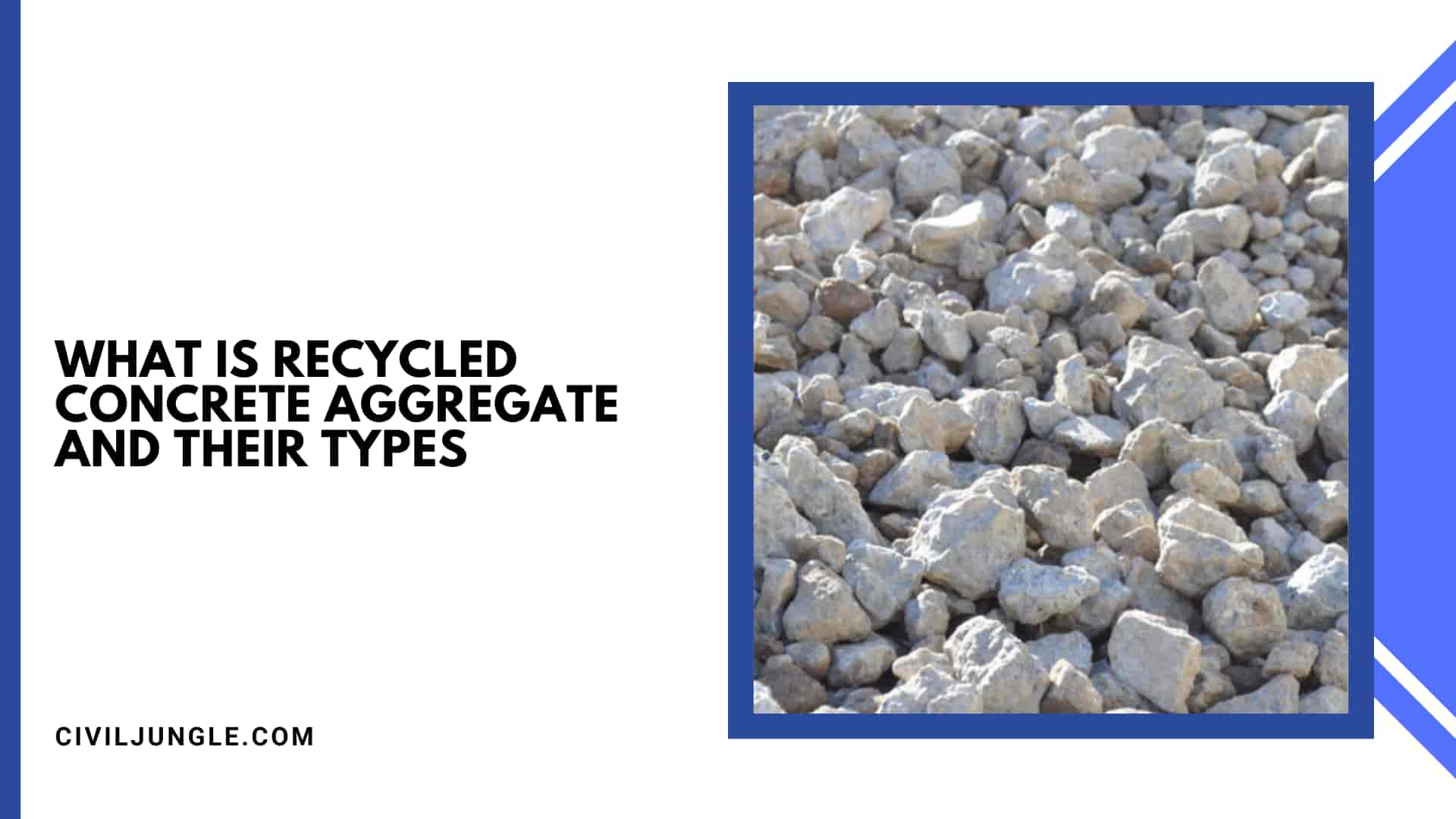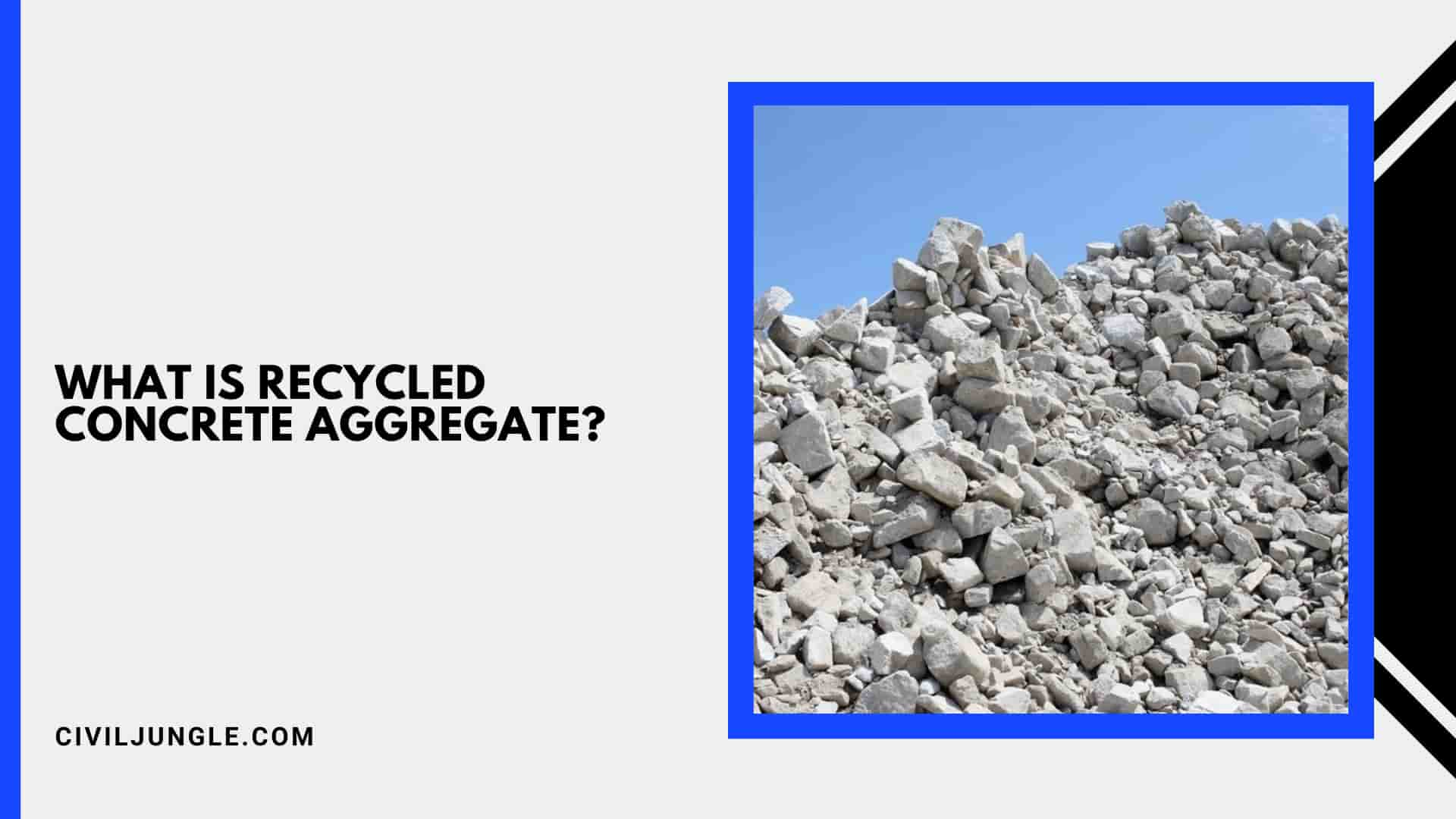Introduction of Recycled Concrete Aggregate
Important Point
- Concrete recycling Aggregate is the use of debris generated from the concrete structures of a demolished building. Aggregate is used most in every construction activity.
- According to one estimate, the highest use of aggregate in construction was in Asia and the Pacific.
- Demolition is done on a large scale to demolish the old building and build a new one based on the new requirements so that the concrete structure produces a large amount of waste.
- The waste from the structure of such concrete should be dumped in a landfill as an alternative, but it can pollute the air and water. For this, the demolition of concrete was considered for the proper use of solid waste.
- With the use of this construction, more and more countries have considered the importance of recycling demolition waste.
What Is Recycled Concrete Aggregate?
Recycled concrete aggregates are obtained by recycling from broken concrete structures, which are used for concrete or other purposes.
Recycled Concrete Aggregates are recycled by using Heavy industrial crushing equipment. In this heavy crushing equipment, the broken concrete is crushed by jaws and a large impactor.
After the concrete is broken, it is usually removed by secondary equipment to separate the dirt and separate the large and small aggregate.
In addition, other elements can be removed from broken concrete using methods such as water flotation, separators, and magnets.
Also Read: All Cement Price List Today
The Importance of Concrete Recycling Aggregate
Solid waste is generated through the construction and demolition (C&D) process, which is about 25 percent of the national solid waste in the US.
According to a US EPA survey, the largest portion of C&D material is concrete solid waste. This solid waste has generated a total of 375 million tons of material through construction (21.7 million tons) and demolition (353.6 million tons) activities.
According to one estimate, the highest use of aggregate in construction was in Asia and the Pacific country.
The demolition of the building for the need for new construction generates a large amount of waste. The common way to dispose of this concrete waste is to throw it in a landfill, which pollutes the air and water.
Crushed aggregates can be used to reduce total construction costs. In addition, recycled concrete aggregate can be used for road edges.
Recycled concrete aggregate is a cheap and ecological use of broken concrete pieces as a filling material in low-lying areas.
Use of Recycled Concrete Aggregate
Well-shaped Recycled concrete can be used in landscaping stone as an aesthetically pleasing material.
Recycled concrete can be used to reduce the use of conventional materials. Through which an environmentally friendly and cost-effective solution can be provided.
We should increase its importance by making more use of recycled materials. So that concrete is used sparingly, and less waste is achieved.
Crushed aggregate separated from broken concrete by removing various impurities can be used as a component of concrete.
Larger sizes of concrete aggregate can be used as a stone in walls, as a slab in the walkway, and to prevent stream bank erosion.
Recycled concrete aggregate can usually be used for new construction on the road pavement, which can be used as a layer for the road.
Structurally recycled concrete aggregate can be used for retaining walls to control erosion on hills.
In addition, recycled concrete aggregate can be used for decoration in terraced gardens.
Also Read: M30 Grade of Concrete Mix Design Procedure with OPC 53 Cement
Difference Between Recycled Concrete Aggregate Vs Natural Aggregate
1. Recycled Concrete Aggregate Vs Natural Aggregate: Density
The main factor affecting the density of recycled concrete aggregate is the aggregate residue on the aggregate. Recycled concrete aggregates get less than natural aggregate density.
According to a study by Limbachiya et al., the relative density of recycled concrete aggregate (saturated surface in the dry state) is about 7-9% lower than natural aggregate.
2. Recycled Concrete Aggregate Vs Natural Aggregate: Porosity and Water Absorption
Natural aggregate generally reduces water absorption due to its low porosity. While recycled concrete aggregate has more porosity due to sticking mortar. So recycled concrete aggregate absorbs more water than natural aggregate.
The study of Limbachiya et al. obtained water absorption values of 0.5-1% for natural aggregate and 4-4.7% for recycled concrete aggregate in the dry state of the saturated surface.
3. Recycled Concrete Aggregate Vs Natural Aggregate: Shape
The recycled concrete aggregate has a more rounded, spherical shape, which improves its efficiency.
Natural aggregate usually has a simple angular shape.
The recycled concrete aggregate allows the new mortar to flow better around it.
4. Recycled Concrete Aggregate Vs Natural Aggregate: Crushing and L.A.Abrasion
Recycled concrete aggregate has higher values for friction than natural aggregate in crushing and friction tests by Los Angeles.
Recycled concrete aggregate value in crushing and friction tests indicates the weakness of the adhesive mortar. Thus, recycled concrete aggregate forms a weaker bond in concrete than natural aggregate.
Process of Recycled Concrete Aggregate
- In urbanization, recycling a piece of broken concrete is done through a proper process. In this process, pieces of concrete can be selected as slabs or bricks.
- Materials like waste, wood, and paper are removed from the pieces of crushed concrete. Metals such as iron are then removed using magnets and other devices.
- Aggregate is separated from crushed concrete by size. The concrete aggregate is then crushed using a crushing machine. Other impurities are then removed by methods such as water flow.
- Crushing the building construction site using portable crushers makes transportation cheaper. And less pollution is produced due to less transportation.
- Concrete and asphalt debris can be crushed by a large road-portable plant with a capacity of 600 tons per hour.
- This type of plant includes a side discharge conveyor, a screening plant, and a screen of large chunks for re-crushing large parts.
- Self-contained crushers can crush a piece of concrete up to 150 tons per hour. It can make this type of crushing plant economic for small volumes.
Advantages & Disadvantages of Recycled Concrete Aggregate
Advantages of Recycled Concrete Aggregate
- A portable crusher plant can be used to crush a piece of concrete on site. So as to reduce transportation costs and pollution from transport to dump.
- Crushing of pieces of concrete is possible on-site by the plant, which reduces the cost of transporting materials and waste.
- It is used by recycling broken pieces of concrete as proper aggregate. This can save landfill space for scrap pieces of concrete.
- Recycled aggregate concrete is reliable and safe to use as a layer for road pavements.
- Recycled Concrete Aggregate increases new employment opportunities.
- Well-shaped Recycled concrete can be used in landscaping stone as an aesthetically pleasing material.
Disadvantages of Recycled Concrete Aggregate
- Recycled Concrete Aggregate absorbs excess water so that its strength is reduced.
- Using Recycled Concrete Aggregate reduces concrete quality.
- The use of Recycled Concrete Aggregate reduces the efficiency of concrete.
- The use of recycled concrete aggregate reduces the durability of concrete.
Recycled Concrete Aggregate Price
Recycled Concrete Aggregate in the USA costs about $ 15 to $ 50 per ton, about $ 18 to $ 80 per cubic yard, depending on aggregate size.
Like this post? Share it with your friends!
Suggested Read –
- Steel Plate Load Capacity Calculator
- Types of Columns Used in Construction
- What Is Bridge Abutment And Their Uses
- What Is Butterfly Roof And Thier Pros and Cons
- What Is Metal Roof Insulation And Their Options
What Is Recycled Concrete Aggregate (RCA)?
Recycled Concrete Aggregate is the crushed debris obtained from demolished concrete structures, which is then reused as a substitute for natural aggregates in construction activities.
What Are the Benefits of Using Recycled Concrete Aggregate?
Recycling concrete reduces waste in landfills, conserves natural resources, lowers construction costs, promotes sustainability, and creates job opportunities in recycling and construction sectors.
How Is Recycled Concrete Aggregate Obtained?
RCA is obtained by crushing and processing demolished concrete using heavy industrial equipment. The crushed concrete is then separated from impurities and sorted based on size for various construction applications.
What Are the Different Uses of Recycled Concrete Aggregate?
RCA can be used as a filling material, for landscaping purposes, in road construction, retaining walls, erosion control measures, and as a component in concrete production.
Is Recycled Concrete Aggregate as Strong as Natural Aggregate?
RCA may have slightly different properties compared to natural aggregates. While it offers good strength and durability, it may absorb more water and have different friction characteristics, which can be managed effectively in construction projects.



Leave a Reply